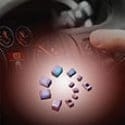source: AVX news
Qualified to AEC-Q200, the new Automotive Grade Accu-P Series SMD capacitors deliver the industry’s tightest capacitive tolerances, in addition to exceptionally repeatable performance, extremely high stability, & remarkably low ESR & high Q at high frequencies
FOUNTAIN INN, S.C. (February 9, 2017) – AVX Corporation, a leading manufacturer and supplier of passive components and interconnect solutions, has released a new series of SMD thin film chip capacitors especially designed to meet demanding performance specifications in automotive signal and power applications. Qualified to AEC-Q200, AVX’s new Automotive Grade Accu-P® Series capacitors deliver the tightest tolerances of any capacitor available on today’s market (down to ±0.01pF), in addition to exceptionally repeatable performance, remarkably low ESR and high Q at high frequencies (including VHF, UHF, and RF bands), and extremely high stability with respect to temperature, time, frequency, and voltage variation when compared to ceramic capacitor technologies.
Based on well-established thin film technology and materials, the new Automotive Grade Accu-P Series capacitors are also subjected to a litany of test and quality control procedures in accordance with ISO 9001, CECC, IECQ, and USA MIL — including on-line process control procedures, accelerated life, dampness, and heat testing, and final quality inspections for capacitance, proof voltage, IR and breakdown voltage distribution, temperature coefficient, solderability, and dimensional, mechanical, and temperature stability — which makes them ideal for use in automotive signal and power applications that require extremely high accuracy, such as: in-vehicle and vehicle-to-vehicle communications systems, vehicle location and alarm systems, GPS, in-cabin wireless LANs, and mobile communications including navigation, traffic information, and connected security systems.
“Designed to exhibit ideal performance characteristics in high frequency signal and power applications, Accu-P Series capacitors virtually eliminate the variances in dielectric quality, electrode conductivity, and physical size that are inherent to ceramic capacitor technologies,” said Larry Eisenberger, principal technical marketing engineer, AVX. “Named for the extreme accuracy they deliver in even demanding applications, Automotive Grade Accu-P Series SMD thin film chip capacitors feature high-purity electrodes for very low and repeatable ESR; high-purity, low-K dielectric for a high breakdown field, high IR, and low losses to frequencies above 40GHz; and very tight dimensional control for uniform unit-to-unit inductance.”
Automotive Grade Accu-P Series capacitors are currently available in three standard case sizes (0402, 0603, and 0805), six rated voltages (10V, 16V, 25V, 50V, 100V, and 200V), and two dielectric temperature coefficients (0±30ppm/°C and 0±60ppm/°C) with capacitance values spanning 0.05pF to 68pF, and capacitive tolerances from ±0.01pF to ±5%. Rated for use in operating temperatures spanning -55°C to +125°C, the ruggedly constructed series also offers four termination compositions, including RoHS compliant and lead-free compatible options, and nickel/solder-coated terminations that provide excellent solderability and leach resistance.
Designed for soldering onto flexible or alumina circuit boards, Automotive Grade Accu-P Series capacitors can withstand the time and temperature profiles used in both wave and reflow soldering methods. Shipped on 7” or 13” reels, the components should be handled with plastic-tipped tweezers, vacuum pick-ups, or other pick-and-place machinery. Lead-time for the series is currently 10 weeks.































